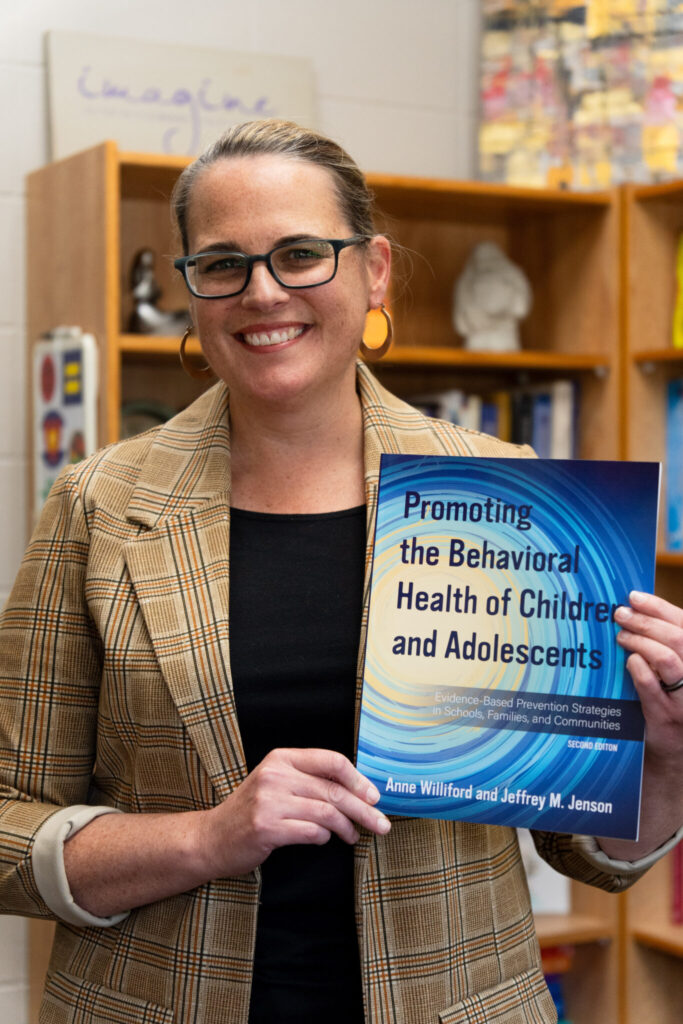
Anne Williford, associate professor at Colorado State University’s School of Social Work, advocates for proactive prevention in her new book, “Promoting the Behavioral Health of Children and Adolescents: Evidence-Based Prevention Strategies in Schools, Families, and Communities,” co-authored with Jeffrey M. Jenson.
This updated second edition offers a comprehensive exploration of the impact of prevention as a tool to build resilient children, families, and communities. Prevention science focuses on providing people tools and education to reduce the risk of harm to their health and well-being, for example, promoting healthy eating and physical activity to prevent chronic diseases.
Williford’s book discusses the pressing need for a transformative shift in social work practice away from predominantly treatment-focused interventions to preventive interventions that have shown significant impact on the behavioral health of young people.
Williford underscores this shift in practice to proactive prevention would not only yield substantial long-term fiscal benefits, but also aligns with the principles of social justice.
“We have concrete proof that prevention saves dollars,” Williford asserted, “and if we actually give families, kids, and communities more front-end support, we might save people from having to go through hardship that could have been prevented, which is definitely a social justice issue.”
Importance of influencing policy
In discussing the importance of working with policymakers to help them understand how prevention investments payoff in the long run, Williford recognizes the challenge of reallocating resources.
“How do we convince policymakers that the front-end investment in upstream prevention is worth it?” she said. “We know that these more reactive treatment-oriented services are incredibly costly, which is not to suggest in any way we don’t need them too. But what if we tried to back up the train a little bit and instead of 5-7% of the U.S. budget being invested in prevention it was 15%? We could start to tip the scales.”
While discussions around prevention science have been ongoing in the field of social work and other allied professions since the 1980s, Williford acknowledged that implementation has been particularly slow within social work. “In recent years, as we have increasingly grappled with intractable social disparities, there’s this sense of urgency to invest in solutions.”
In building thoughtful solutions, Williford emphasized the need for greater integration of preventive measures, citing how recent social movements for change have created a pivotal moment for advancing social justice through direct investment into programs that center the health of communities and families. She argues that the time is now to invest in prevention to support the health and well-being of youth, families, and communities especially communities that have long experienced oppression in our society.
Role of culture in prevention
In her book, Williford also highlights the significant progress made in cultural adaptation within preventive programs, a topic she passionately discusses.
“There’s been a huge growth in how we think about culturally adapting programs. In writing that chapter, it was exciting to think about the ways in which our own profession has grown to understand the implications of white-centered knowledge shaping practice and trying to disrupt some of that,” she shared.
As discussed in her book, adapting preventive interventions in systematic ways centers the cultural knowledge, practices, values, and customs of diverse communities. And such adaptations stand to improve not only the relevance of a program but also its impact. To that end, Williford talks about the power of participatory methodologies, which can empower communities to shape programs that align with their unique needs and experiences.
The importance of evidence-based practice, and the role social workers must play in implementing culturally adapted programs in their communities is an important take-away from the book. While acknowledging that more work is needed to build equitable systems, Williford remains hopeful that greater integration of evidence-based prevention can drive positive change within the field of social work and be used as a tool to advance social justice.
“Often as social workers we’re working in systems that are not really designed for prevention like child welfare or mental health.” she explained. “We’re connecting with people who have already experienced significant adversity by the time they’re reaching these systems. And yet, even in these systems we can still adopt a preventative mindset. We can prevent people from struggling further.”
The School of Social Work is part of CSU’s College of Health and Human Sciences.